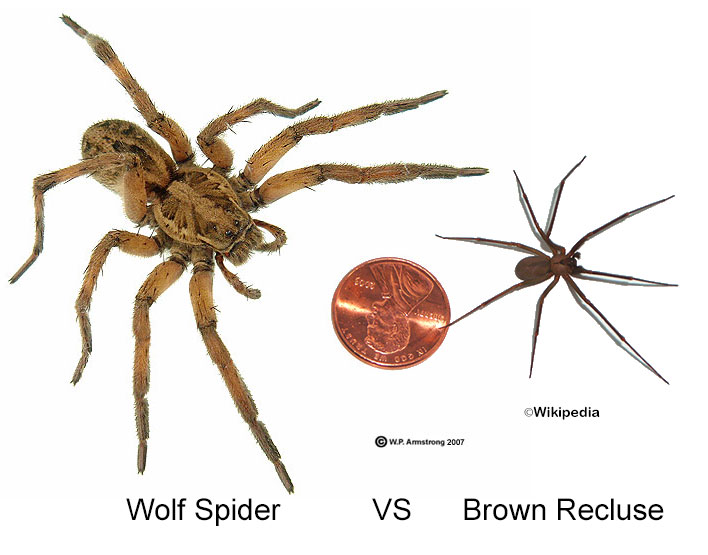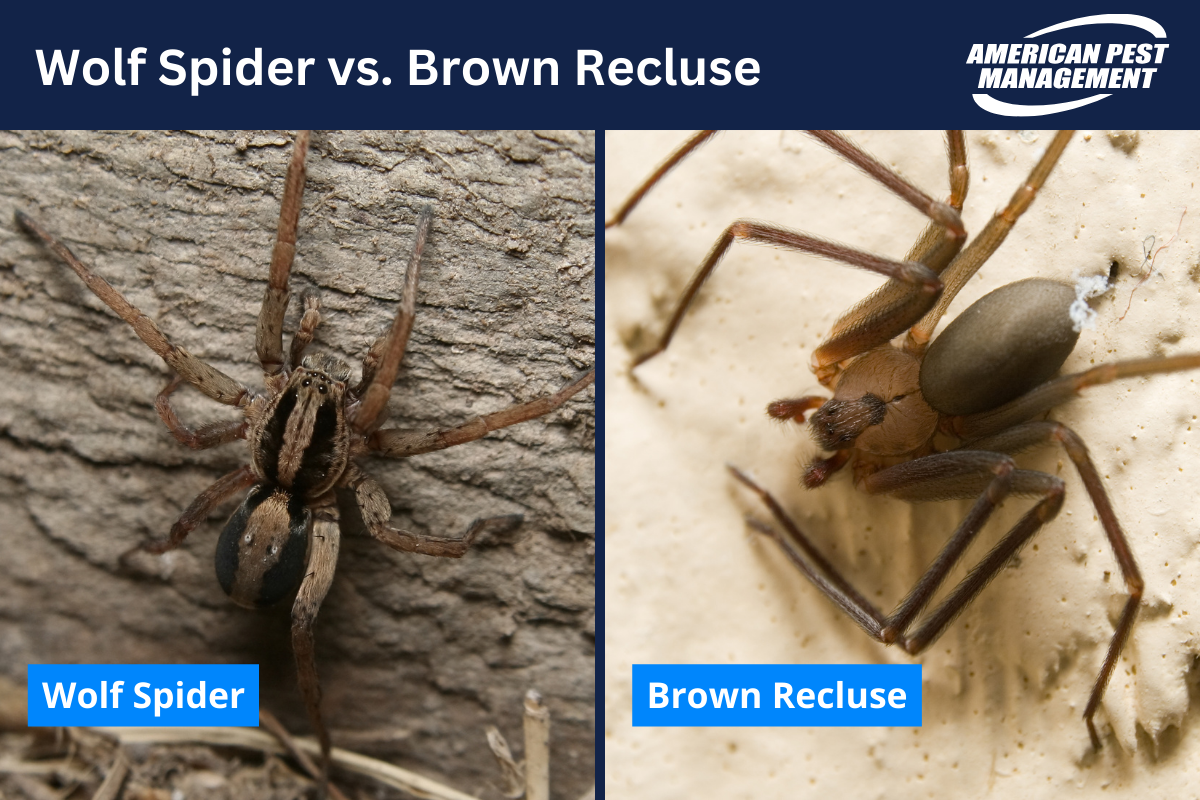Are you curious about the creepy crawlies lurking in your backyard? If you’ve ever stumbled upon a spider in your home, you might have wondered if it’s a friend or foe.
Two spiders often causing confusion are the wolf spider and the brown recluse. While both might send a shiver down your spine, understanding their differences could be crucial for your safety and peace of mind. Would you like to know how to identify them and what to do if you spot one?
Keep reading to unravel the mysteries of these fascinating yet fearsome spiders, and discover which one poses a real threat to you and your loved ones. This knowledge could be more valuable than you think!

Credit: mygreenhousepro.com
Physical Characteristics
Wolf spiders boast a robust, hairy appearance, often growing larger than brown recluses. Brown recluse spiders have a distinct violin-shaped mark on their back. Their size is typically smaller, making them less noticeable.
In the world of spiders, the wolf spider and the brown recluse often capture attention. Their physical traits are unique and help in distinguishing them. Understanding these features can aid in identifying these spiders easily.Size And Shape
Wolf spiders are generally larger than brown recluses. They range from 0.5 to 2 inches in size. Their bodies appear robust and hairy. Brown recluses are smaller, about 0.25 to 0.75 inches long. Their bodies are more delicate and smooth.Color Patterns
Wolf spiders usually have a mix of brown, gray, and black hues. Their bodies display bold patterns that help them blend into surroundings. Brown recluses are light brown with a uniform appearance. They have a distinct violin-shaped mark on their back.Distinctive Features
Wolf spiders have eight eyes in three distinct rows. Their eyesight is excellent, aiding in hunting. Brown recluses have six eyes arranged in pairs. This feature sets them apart from most spiders with eight eyes. Their legs are long and slender, unlike the wolf spider’s stocky legs.
Credit: spearspestcontrol.com
Habitat And Distribution
Wolf spiders and brown recluse spiders live in different places. Their habitats affect where they are found. Understanding their environments helps identify them.
Preferred Environments
Wolf spiders prefer open areas. They like grasslands and gardens. They are often seen in forests too. These spiders do not build webs. They hunt on the ground.
Brown recluse spiders like hidden places. They live indoors and outdoors. They prefer dark corners and crevices. They build webs to catch prey.
Geographical Range
Wolf spiders have a wide range. They are found across the world. They adapt to different climates easily. This makes them common in many regions.
Brown recluse spiders are less widespread. They are mostly in the United States. Their range is in the Midwest and South. They are not found everywhere.
Behavioral Traits
Wolf spiders and brown recluses exhibit distinct behaviors. Wolf spiders actively hunt and move swiftly in the open. Brown recluses prefer hiding in dark, quiet spaces, rarely leaving their webs.
Understanding the behavioral traits of spiders can often mean the difference between a mild curiosity and a necessary caution. When it comes to the Wolf Spider and the Brown Recluse, knowing how they behave can help you identify and avoid them in your home or garden. These spiders have distinct habits that set them apart, making it easier for you to spot and manage them effectively.Hunting Techniques
Wolf Spiders are known for their dynamic hunting style. Unlike many spiders that weave webs to catch prey, Wolf Spiders actively chase and pounce on their targets. Their keen eyesight and fast reflexes make them efficient hunters, often seen darting across the ground in pursuit of insects. In contrast, the Brown Recluse prefers a more passive approach. They build irregular webs in secluded areas and wait patiently for unsuspecting prey to wander into their trap. This method allows them to conserve energy, striking only when necessary. You might wonder which approach is more effective. It largely depends on the environment and available prey. Wolf Spiders thrive in open areas where speed is an advantage, while Brown Recluses excel in cluttered spaces where stealth is key.Activity Patterns
Wolf Spiders are primarily nocturnal creatures, meaning they are most active at night. This behavior helps them avoid predators while hunting. You might notice them if you’re out late in your garden or yard. Brown Recluses, on the other hand, also prefer the cover of darkness but are less active hunters. They often remain hidden during daylight hours, emerging only when necessary to feed or mate. Their reclusive nature is a double-edged sword—while it keeps them safe, it also makes them harder to notice. Have you ever spotted a spider scurrying across your floor at night? It could be a Wolf Spider on the hunt. On the other hand, if you’ve stumbled upon a hidden web in your garage or basement, a Brown Recluse might be nearby. Understanding these patterns can help you manage your environment to minimize unwanted encounters. Are there ways you can adjust your home or garden setup to deter these spiders? Perhaps reducing clutter or sealing entry points could be an effective strategy.Venom And Bite Effects
Wolf spiders and brown recluse spiders are often misunderstood due to their venom. Understanding the effects of their bites is crucial for safety and treatment.
Venom Potency
Wolf spider venom is mild compared to other spiders. It usually causes irritation and mild pain. The bite is not life-threatening. Brown recluse venom is more potent. It contains enzymes that can cause tissue damage. This can lead to necrosis, which is the death of skin cells.
Symptoms And Treatment
Wolf spider bites may cause redness and swelling. The area can be itchy and painful. Most symptoms resolve without medical intervention. Brown recluse bites can be more severe. The skin may become red and blister. Over time, the blister may turn into an ulcer. This requires prompt medical treatment to prevent complications.
Treat wolf spider bites with ice and antihistamines. For brown recluse bites, seek medical care immediately. Doctors might prescribe antibiotics or pain relief. In severe cases, surgery may be necessary to remove damaged tissue.
Interaction With Humans
Wolf spiders and Brown Recluse spiders often cause fear due to their appearance. Wolf spiders are typically harmless and avoid humans. Brown Recluse spiders can bite if provoked, leading to serious reactions. Understanding their behavior aids in safe interaction with these arachnids.
When it comes to spiders, encounters with the wolf spider and the brown recluse can lead to varied experiences for humans. While both spiders are common across many regions, their interactions with humans differ significantly. Understanding these differences can help you navigate any unexpected meetings more safely and knowledgeably.Encounters And Risks
Imagine reaching into your garage storage and feeling something scurry across your hand. In many homes, this could be a wolf spider, known for its speed and size. These spiders are generally harmless, though their appearance can be startling. On the other hand, the brown recluse is a more insidious house guest. Often hiding in dark, undisturbed areas like basements or closets, they tend to avoid human contact. However, their bites can cause serious skin reactions, making them more of a health concern than wolf spiders. Do you know how to identify these spiders? Wolf spiders are larger, with a hairy body and a more robust appearance. Brown recluses are smaller, with a distinctive violin-shaped marking on their back. Knowing these features can help you distinguish between a benign encounter and one that requires caution.Preventive Measures
So, how can you prevent these unwanted interactions? Start by keeping your living spaces clean and clutter-free. Spiders thrive in messy, undisturbed areas, so regular cleaning can reduce their hiding spots. Seal any cracks or gaps in windows and doors to keep spiders out. Consider using natural deterrents like essential oils; peppermint oil is known to repel spiders effectively. Inspect and shake out clothing or shoes that have been stored for long periods. This simple habit can prevent unpleasant surprises, especially in areas known for brown recluse activity. Have you checked your home for these potential hideouts? Taking proactive steps can significantly reduce the risks associated with these spiders. By knowing what to look for and how to act, you can ensure your home remains a safe, spider-free zone.Ecological Role
Spiders play vital roles in nature. They balance ecosystems and control insect populations. Wolf spiders and brown recluse spiders are no exception. Each species has unique ecological contributions. Let’s explore their roles in detail.
Prey And Predators
Wolf spiders are active hunters. They prey on insects and small arthropods. Their speed and keen eyesight help them catch prey. Brown recluse spiders prefer a different approach. They use webs to trap unsuspecting insects. Both species are preyed upon by birds and other animals. Larger spiders and lizards also hunt them.
Impact On Ecosystem
Wolf spiders help control pest populations. They contribute to healthy garden ecosystems. By reducing insect numbers, they protect crops. Brown recluse spiders also play a role. They keep household pests in check. Their presence can reduce the need for chemical pest control. Both spiders contribute to biodiversity. Their actions support a balanced ecosystem.

Credit: americanpestonline.com
Frequently Asked Questions
What Are The Main Differences Between Wolf Spider And Brown Recluse?
Wolf spiders are larger with hairy bodies. Brown recluse spiders are smaller with a violin-shaped mark on their back.
Are Wolf Spiders Dangerous To Humans?
Wolf spiders are not aggressive. Their bites are painful but rarely cause serious harm to humans.
How Can You Identify A Brown Recluse Spider Bite?
Brown recluse bites cause redness, blistering, and pain. Severe reactions can result in necrotic wounds needing medical care.
Where Do Wolf Spiders And Brown Recluse Spiders Live?
Wolf spiders prefer outdoor environments. Brown recluse spiders often hide indoors in dark, undisturbed areas.
What Should You Do If Bitten By A Brown Recluse?
Clean the bite area. Apply ice to reduce swelling. Seek medical attention if symptoms worsen or do not improve.
Conclusion
Comparing wolf spiders and brown recluses helps us understand these creatures better. Both have unique traits. Wolf spiders actively hunt and are not dangerous to humans. Brown recluses have a venomous bite but are not aggressive. Knowing their differences helps in identification and safety.
Always observe spiders from a safe distance. This knowledge keeps you informed and prepared. Respecting their role in nature is essential. Both species contribute to a balanced ecosystem. Stay aware and cautious. With this information, you can coexist peacefully with these spiders.
Appreciate their place in our world.




